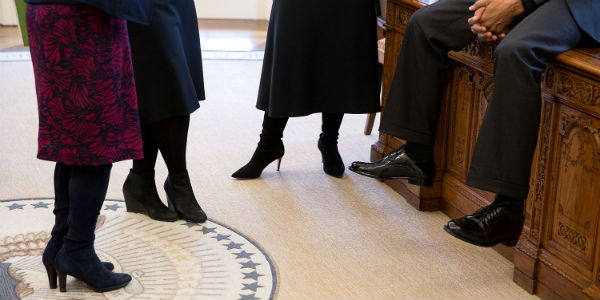Female cabinet picks: just one more way in which Trump is exceptional
Donald Trump’s cabinet is exceptional in many ways, not least because the share of women in the executive has fallen since the Obama era – even as recent decades have seen it grow all over the world. What effect does government ideology have on cabinet picks? The literature suggests left-wing governments tend to appoint more women. But new research by Daniel Stockemer and Aksel Sundström suggests the link is not straightforward. What in fact prompts women’s promotion is a change of government ideology. In this respect – as in so many others – the Trump administration is an outlier.

Photo: Obama White House via United States government works
Donald Trump’s cabinet appointees are controversial for a number of reasons – not the least the background of several candidates. One of the ways in which it breaks with recent administrations is that it has a lower proportion of women than the previous administration did. Researchers have criticised the failure to nominate more women and people from ethnic minorities; the New York Times described Trump’s cabinet as “more white and male than any first cabinet since Reagan’s”.
Daniel Stockemer and I analysed the share of women in cabinets across mainly industrialised countries since 1968, and focused on testing the impact the ideology of the party in government had on that proportion. Our findings, presented in a recent article, confirm that Trump’s cabinet is an exception: in a comparison across countries and years, each change in government tends to result in an increasing share of women in cabinet positions. In other words, countries where the government’s ideology has changed tend to have a cabinet with a larger proportion of women than those where the ideological composition stays unchanged.
Because feminism and socialism are ideologically compatible – and because women’s organisations and movements play a relatively large role in left-wing parties – the literature suggests that a left-wing administration will nominate more women than a liberal or conservative one. Previous studies on the gendered composition of cabinets generally found this to be the case. Yet that research was rather limited because it looked at cross-country designs in a single timespan, or sampled certain geographic regions.
In fact, we found the effect of a left-wing administration to be less straightforward. Indeed, in some periods liberal governments have nominated a bigger share of women than their left-wing counterparts. The lack of support for a clear positive effect from left-wing ideology is confirmed also when estimating this in different types of statistical models. Instead, we find that changes in government tend to have a positive effect, regardless of whether the new government is socialist, liberal or conservative. We believe that this finding has previously been overlooked.
The dearth of women in the Trump cabinet highlights the need to monitor the gendered composition of executive roles. While all-male cabinets are increasingly atypical, the “parity-cabinet” – such as the 2015 Trudeau cabinet in Canada, where an equal number of women and men were chosen – remains a rare phenomenon.
Full article: Stockemer, Daniel and Aksel Sundström (2017) “Women in cabinets: The role of party ideology and government turnover” Party Politics, online first.
This post represents the views of the authors and not those of Democratic Audit.
 Aksel Sundström (PhD, 2015) is a postdoctoral researcher affiliated to the Quality of Government (QoG) Institute, University of Gothenburg, Sweden. He will be a Visiting Democracy Fellow at Harvard Kennedy School of Government in the academic year 2017-2018. His work on comparative politics has appeared in outlets such as Electoral Studies, European Journal of Political Research and World Development.
Aksel Sundström (PhD, 2015) is a postdoctoral researcher affiliated to the Quality of Government (QoG) Institute, University of Gothenburg, Sweden. He will be a Visiting Democracy Fellow at Harvard Kennedy School of Government in the academic year 2017-2018. His work on comparative politics has appeared in outlets such as Electoral Studies, European Journal of Political Research and World Development.





 Democratic Audit's core funding is provided by the Joseph Rowntree Charitable Trust. Additional funding is provided by the London School of Economics.
Democratic Audit's core funding is provided by the Joseph Rowntree Charitable Trust. Additional funding is provided by the London School of Economics.